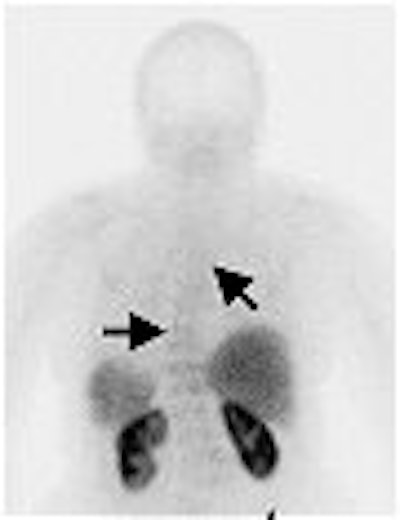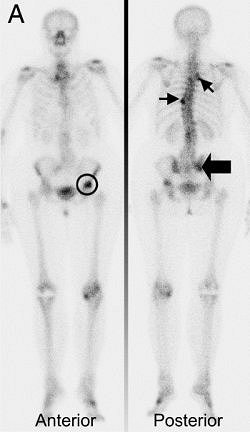
Only a third of breast cancer patients who have endocrine therapy respond to treatment, and the current tests for patient selection are less than optimal. In vitro assessment of hormone receptor status requires tissue sampling and isn't all that accurate. Other imaging techniques may not show results for several months post-treatment. Scintigraphy could be a better, noninvasive way to predict treatment response, according to European researchers.
"A decline in effective therapy may lead to a decline in performance status and organ function and, as such, reduce the likelihood of a subsequent response," wrote Dr. Bieke Van Den Bossche, Ph.D., and colleagues in the Journal of Nuclear Medicine. "This study was undertaken to evaluate the potential of sequential (technetium-99m)-depreotide scintigraphy to select patients likely to respond to endocrine therapy ... as early as three weeks after initiation of treatment" (January 2006, Vol. 47:1, pp. 6-13).
Van Den Bossche is from the nuclear medicine department at Ghent University Hospital in Ghent, Belgium. Her co-authors are from Ghent's department of medical oncology, the OLV Hospital in Aalst, and the University "La Sapienza" in Rome.
For this small study, 18 women (mean age of 63 years) were enrolled. Seventeen patients had progression of previously treated breast cancer; one had a first diagnosis of locally advanced cancer. They underwent scintigraphy at baseline, before hormonal treatment, and three weeks later.
Planar whole-body and SPECT imaging was performed after the injection of 555-740 MBq of Tc-99m depreotide (NeoSpect/NeoTect, GE Healthcare, Chalfont St. Giles, U.K.). Images were acquired on a double-head or triple-head gamma camera (Axis or Irix, Philips Medical Systems, Andover, MA).
 |
| Seventy-four-year-old woman, under tamoxifen treatment, presented with positive bone scan showing multiple lesions in vertebral spine T3 and ribs, T9 (small arrows), right sacroiliac region (thick arrow), and left femur (circle). |
Patients with stable disease for at least six months were considered responders to therapy. Those with disease progression within six months were deemed nonresponders. A change of more than 25% between the baseline and follow-up scan was considered significant.
The mean follow-up time was 20 months, during which time four patients died. According to the results, eight patients had stable disease and 10 were nonresponders at the six month mark.
 |
| Tc-99m depreotide scintigraphy, assessed before switch to second-line hormonal therapy, was negative. She was a nonresponder and the number of bone lesions increased. Bieke Van Den Bossche, Simon Van Belle, Frederic De Winter, Alberto Signore, and Christophe Van de Wiele. "Early Prediction of Endocrine Therapy Effect in Advanced Breast Cancer Patients Using 99m-Tc-Depreotide Scintigraphy" J Nucl Med 2006; 47;6-13, Figure 3. |
"All responders had positive baselines scans, and seven of 10 nonresponders had negative baseline scans. Thus, all patients with a negative scan did not respond to therapy," the authors stated. The positive predictive value for baseline scintigraphy was 73%, while the negative predictive value was 100%.
The group also found that the relative change in radiotracer uptake differed in responders (uptake decrease) versus nonresponders (uptake increased). The median change in lesion-to-background ratio was -19% in responders and 34% in nonresponders.
Van Den Bossche's group called for a larger study to confirm their findings. They concluded that scintigraphy has the potential to be "a powerful tool to accurately evaluate endocrine responsiveness."
By Shalmali Pal
AuntMinnie.com staff writer
January 26, 2006
Related Reading
Switch from tamoxifen to anastrozole benefits women with early breast cancer, August 5, 2005
Progesterone receptor may have a protective role in breast cancer, August 6, 2005
Copyright © 2006 AuntMinnie.com




















